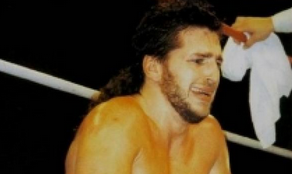Subscribe to the podcast via: iTunes | RSS Feed | Email Newsletter
Barr found his break in the late 1980s, Roddy Piper took inspiration from a film called Beetlejuice to assign Barr a children’s favourite character of the same name. With flour on his head, and makeup on his face it seemed like an odd choice, but in Pacific Northwest Wrestling in Oregon it worked. There are great videos on Youtube of “Beetlejuice” leading a torrent of children in a dance around the ring.
The character took him to WCW – where for legal reasons he was renamed “The Juicer”. But around the same time Barr got into serious trouble after being accused of raping a 19-year-old girl. Despite pleading his innocence, Barr took a plea bargain which meant he avoided jail. He attempted to restart his wrestling career in America but after bad local press in Oregon and some campaigning towards WCW (he received “rapist” chants in some areans) – it just wasn’t going to happen. So he went to Mexico.
It was there that his career really took off. Now under a mask, and called “Love Machine” (yeah, tasteful), Barr found a place where his perceived lack of size didn’t matter. He got over, big time. He and Blue Panther sold out a 17,000 seat building in April of 1992, losing his mask. The duo rematched in 1993, with Barr this time losing his hair in a hair vs mask match. That match sold over 20,000 tickets in Guadalajara.
But it was a heel turn, and an alignment with Eddy Guerrero that really kicked Barr’s career into the next gear. He and Guerrero formed “Los Gringos Locos” (The Crazy Americans), who came to the ring in Stars and Stripes tights. Guerrero, having honed his skills in Japan, and Barr with his American style changed Mexican wrestling. At theAAA When World’s Collide show, Barr lost another hair vs mask match and he and Guerrero had to be shaved. The show, in Los Angeles at a time when both the WWF and WCW were really struggling, sold out. Maybe it was time for Love Machine to come back to the States?
Unfortunately for Barr he wouldn’t even live to see 1995, passing away three weeks later with no official cause of death ever determined. Relations in Oregon, and in the States, seemed to have been quelled. Given Barr’s success there’s a quite decent case to say that Barr was the biggest American wrestling star in the world at that time, such were the fortunes of the two major American promotions, not that you couldn’t overlook that fact. When Terry Taylor was throwing Guerrero under a bus on a WCW hotline a few weeks prior to the start of the Monday Night War, he claimed that Guerrero “hadn’t drawn in the States”. Which, while hardly even the point wasn’t even true.
It seems inconceivable that Barr wouldn’t have gone on to be a difference maker in the States. An English speaking Mexican star would’ve been a great asset to WCW (WWF would’ve been too slow) at the beginning of the battle. Paul Heyman was reportedly eyeing the pair for a run in ECW – which given the presence of The Public Enemy and The Steiner Brothers could’ve been an excellent watch.
Barr had also started working Japan that year with Guerrero. And Konnan had big plans for them back in Mexico too. Barr passed away aged 28, given his ability and his drawing power at the time, he would’ve had a great opportunity at becoming a big star in the US – or at least a well-known one. Now we can only look at what might have been.

 RSS Feed
RSS Feed